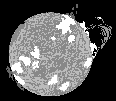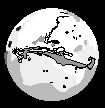 Sun: Color the entire disk of the Sun yellow. Add orange and red
over the mottled areas of the Sun's surface. Leave the white areas
yellow. Color the prominences shooting out from the surface red.
Sun: Color the entire disk of the Sun yellow. Add orange and red
over the mottled areas of the Sun's surface. Leave the white areas
yellow. Color the prominences shooting out from the surface red.
 Mercury: Color the entire planet light gray.
Mercury: Color the entire planet light gray.
 Venus: Color the entire planet orange. Darken the shaded areas
with tan or light brown.
Venus: Color the entire planet orange. Darken the shaded areas
with tan or light brown.
 Earth: Color the oceans blue. Leave the clouds and the ice of
Antarctica white. Color Africa and Madagascar tan with a green tint.
Make the darker shaded areas slightly more brown.
Earth: Color the oceans blue. Leave the clouds and the ice of
Antarctica white. Color Africa and Madagascar tan with a green tint.
Make the darker shaded areas slightly more brown.
 Mars: Color the entire planet orange.
Mars: Color the entire planet orange.
 Jupiter: Color the light areas yellow. Make the red spot and the
shaded band near it reddish. Color all shaded bands orange with a slight
red tint.
Jupiter: Color the light areas yellow. Make the red spot and the
shaded band near it reddish. Color all shaded bands orange with a slight
red tint.
 Saturn: Color the entire planet and its rings tan or light orange.
Saturn: Color the entire planet and its rings tan or light orange.
 Uranus: Color the entire planet blue green.
Uranus: Color the entire planet blue green.
 Neptune: With the exception of some white clouds near the Great
Dark Spot, color the entire planet light blue. Make the spot and the
shaded bands darker blue.
Neptune: With the exception of some white clouds near the Great
Dark Spot, color the entire planet light blue. Make the spot and the
shaded bands darker blue.
 Pluto and Charon: Color the fuzzy outer edges light blue. Leave the
centers white.
Pluto and Charon: Color the fuzzy outer edges light blue. Leave the
centers white.
 Comet: Leave white.
Comet: Leave white.
 Asteroid: Color the entire asteroid light gray.
Asteroid: Color the entire asteroid light gray.